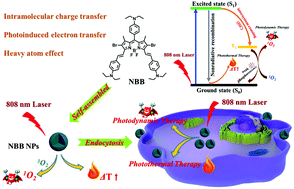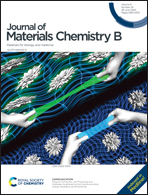Highly efficient near-infrared BODIPY phototherapeutic nanoparticles for cancer treatment†
Abstract
BODIPYs are highly potential photoactive agents for cancer theragnostics. The rational design of BODIPY-based photoactive nanodrugs with high efficiency and near-infrared (NIR) absorption is imperative. Herein, we developed a donor–acceptor–donor (D–A–D) organic photosensitizer (PS) (BODIPY, named NBB), which possessed strong absorption in the NIR region due to the multi-intersection of intramolecular charge transfer (ICT), photoinduced electron transfer (PET), and heavy atom effects. Through a nanoprecipitation method, NBB nanoparticles (NPs) were facilely prepared. The as-prepared NBB NPs exhibited favorable water-stability and photostability. In particular, the outstanding photon absorption capacity endows the NPs with high photothermal conversion efficiency (η = 53.8%) and active singlet oxygen (1O2) generation ability upon 808 nm laser irradiation, and promotes their tumour inhibition efficiency via the combination of photothermal/photodynamic therapy (half-maximal inhibitory concentration IC50 = 8.11 and 7.77 μM for HeLa and HepG2 cells, respectively). Together with the favorable synthetic yield and excellent antitumour effect, we envision that this exploration can provide beneficial guidance for the clinical translation of BODIPY-based PSs for phototherapy.



 Please wait while we load your content...
Please wait while we load your content...